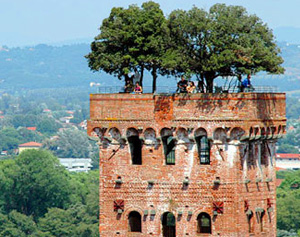 Lucca is one of the main towns of art of Italy, and it is known also outside the national borders, first of all for its intact city walls of the XV-XVII century, which describes a perimeter of 4450 m, around the historic core of the city and makes Lucca one of the 4 provincial Italian capitals to have an intact city walls, along with Ferrara, Grosseto, Bergamo; this town walls were already transformed in a lovely walk in the second half of nineteenth century, and today it is considered one of the best preserved in Europe, as ever used in past centuries for defensive purposes.
Lucca is one of the main towns of art of Italy, and it is known also outside the national borders, first of all for its intact city walls of the XV-XVII century, which describes a perimeter of 4450 m, around the historic core of the city and makes Lucca one of the 4 provincial Italian capitals to have an intact city walls, along with Ferrara, Grosseto, Bergamo; this town walls were already transformed in a lovely walk in the second half of nineteenth century, and today it is considered one of the best preserved in Europe, as ever used in past centuries for defensive purposes.
As a consequence, the historical town center of Lucca remained almost intact in its original appearance, therefore can include a variety of architectural value, as the many medieval churches of great architectural richness (Lucca has even been called the “city of 100 churches” because of the presence of numerous churches in the old town, consecrated or not, in the past and nowadays), towers and belfries, and majestic buildings of the Renaissance with its excellent linearity.
 The town is also provided with beautiful urban spaces: the most famous is Anfiteatro Square, designed by the architect Lorenzo Nottolini and built on the ruins of the ancient Roman amphitheater, a really unique construction from the architectural point of view.
The town is also provided with beautiful urban spaces: the most famous is Anfiteatro Square, designed by the architect Lorenzo Nottolini and built on the ruins of the ancient Roman amphitheater, a really unique construction from the architectural point of view.
The main arterial road of the old town center is the tight and medieval Via Fillungo, that includes the most important shops in town.
There are at least two other famous and striking squares in Lucca: San Michele Square, historical center of the town, and San Martino Square, where we can admire the amazing Cathedral of San Martino, the religious fulcrum of the town.
It’s because of this historical and imposing richness that, recently, the old town center of Lucca (including the historical and traditional theater, Teatro del Giglio) has been proposed to be included in the heritage of Unesco.